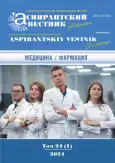Clinical features of coronavirus infection with concurrent olfactory dysfunction
- Authors: Lukyanov A.V.1,2, Ploskireva A.A.1,2
-
Affiliations:
- Central Research Institute of Epidemiology of Rospotrebnadzor
- Pirogov Russian National Research Medical University
- Issue: Vol 24, No 1 (2024)
- Pages: 15-19
- Section: OTORHINOLARYNGOLOGY
- URL: https://bakhtiniada.ru/2410-3764/article/view/263395
- DOI: https://doi.org/10.35693/AVP627315
- ID: 263395
Cite item
Full Text
Abstract
Aim – to identify the clinical features of low-symptomatic forms of COVID-19 coronavirus infection with accompanying olfactory dysfunction.
Material and methods. The study included the survey of people with a history of coronavirus infection conducted on the basis of the Central Research Institute of Epidemiology of Rospotrebnadzor. A total of 39,676 patients were interviewed, of whom 24,086 (60.70%) had suffered some form of new coronavirus infection COVID-19. Methods of descriptive statistics were used for processing the research results.
Results. Olfactory dysfunction was the only symptom of the acute period of COVID-19 infection in 4% of patients. The occurrence of this symptom depended on the dominant circulating genovariant, with the maximum of 7.8% during Alpha, the basic reproduction number (inverse relationship, Pearson correlation coefficient -0.9) and the age of the patient (more often in persons under 44 years of age). The occurrence of the symptom had no correlation with the patient's gender. Patients with olfactory dysfunction during the COVID-19 infection were significantly less likely (4.2% vs. 12.6%, P = 0.04) to require hospitalization and oxygen therapy (2.5% vs. 32.2%, P < 0.001).
Conclusion. Olfactory dysfunction may be the only symptom of the acute period of COVID-19 infection, which allows us to suggest its isolation into a separate form. The occurrence of this form depends on the dominant circulating genovariant, the basic reproductive number of the virus and the age of the patient. Patients with this form of coronavirus infection are less likely to require hospitalization and oxygen therapy.
Keywords
Full Text
##article.viewOnOriginalSite##About the authors
Aleksandr V. Lukyanov
Central Research Institute of Epidemiology of Rospotrebnadzor; Pirogov Russian National Research Medical University
Email: a.sheremetew@yandex.ru
ORCID iD: 0000-0003-3614-886X
a postgraduate student, assistant at the Department of Pediatrics with Infectious Diseases in Children
Russian Federation, Moscow; MoscowAntonina A. Ploskireva
Central Research Institute of Epidemiology of Rospotrebnadzor; Pirogov Russian National Research Medical University
Author for correspondence.
Email: antoninna@mail.ru
ORCID iD: 0000-0002-3612-1889
PhD, Professor of the RAS, Deputy Director for Clinical Work
Russian Federation, Moscow; MoscowReferences
- Lee Y, Min P, Lee S, Kim S.-W. Prevalence and Duration of Acute Loss of Smell or Taste in COVID-19 Patients. Journal of Korean Medical Science. 2020;35(18). https://doi.org/10.3346/jkms.2020.35.e174
- Klopfenstein T, et al. Features of anosmia in COVID-19. Médecine et Maladies Infectieuses. 2020;50(5):436-439. https://doi.org/10.1016/j.medmal.2020.04.006
- Lechien R, et al. Olfactory and gustatory dysfunctions as a clinical presentation of mild-to-moderate forms of the coronavirus disease (COVID-19): a multicenter European study. European Archives of Oto-Rhino-Laryngology. 2020;277(8):2251-2261. https://doi.org/10.1007/s00405-020-05965-1
- Vaira LA. Olfactory and gustatory function impairment in COVID-19 patients: An Italian objective multicenter-study. Authorea. 2020. https://doi.org/10.22541/au.158879175.53282134
- Yan Q, Qiu D, Liu X, et al. Prevalence of Smell or Taste Dysfunction Among Children With COVID-19 Infection: A Systematic Review and Meta-Analysis. Frontiers in Pediatrics. 2021;9. https://doi.org/10.3389/fped.2021.686600
- Voitenkov VB, Ekusheva EV, Bedova MA. Anosmia and ageusia in patients with COVID-19 infection. Folia Otorhinolaryngologiae et Pathologiae Respiratoriae. 2020;3:23-28. (In Russ.). [Войтенков В.Б., Екушева Е.В., Бедова М.А. Аносмия и агевзия у пациентов с инфекцией COVID-19. Folia Otorhinolaryngologiae et Pathologiae Respiratoriae. 2020;3:23-28].
- Sidorovich EA, Askerko MK, Vysotskaya MYu. Prevalence of olfactory and gustatory dysfunction in people who have had COVID-19 (based on survey results). Grodno, 2021:92-94. (In Russ.). [Сидорович Е.А., Аскерко М.К., Высоцкая М.Ю. Распространенность обонятельной и вкусовой дисфункции у лиц, перенесших COVID-19 (по результатам анкетирования). В сб.: Актуальные вопросы микробиологии, иммунологии и инфектологии. Гродно, 2021:92-94]. https://www.elibrary.ru/item.asp?id=47632254
- Hopkins C, Surda P, Kumar N. Presentation of New Onset Anosmia During the COVID-19 Pandemic. Rhinology Journal. 2020;58(3):295-298. https://doi.org/10.4193/rhin20.116
- Le Bon S.-D, Pisarski N, Verbeke J. Psychophysical evaluation of chemosensory functions 5 weeks after olfactory loss due to COVID-19: a prospective cohort study on 72 patients. European Archives of Oto-Rhino-Laryngology. 2020;278(1):101-108. https://doi.org/10.1007/s00405-020-06267-2
- Whitcroft KL, Hummel T. Olfactory Dysfunction in COVID-19. JAMA. 2020;323(24):2512. https://doi.org/10.1001/jama.2020.8391
- Hopkins C, et al. Management of new onset loss of sense of smell during the COVID-19 pandemic – BRS Consensus Guidelines. Clinical Otolaryngology. 2020;46(1):16-22. https://doi.org/10.1111/coa.13636
- Politi LS, Salsano E, Grimaldi M. Magnetic Resonance Imaging Alteration of the Brain in a Patient With Coronavirus Disease 2019 (COVID-19) and Anosmia. JAMA Neurology. 2020;77(8):1028. https://doi.org/10.1001/jamaneurol.2020.2125
- Heneka MT, Golenbock D, Latz E, et al. Immediate and long-term consequences of COVID-19 infections for the development of neurological disease. Alzheimer’s Research & Therapy. 2020;12(1):69. https://doi.org/10.1186/s13195-020-00640-3
- Russell B, Moss C, Rigg A, et al. Anosmia and ageusia are emerging as symptoms in patients with COVID-19: What does the current evidence say? Ecancermedicalscience. 2020;14:ed98. https://doi.org/10.3332/ecancer.2020.ed98
- Moein ST, Hashemian SM, Mansourafshar B, et al. Smell dysfunction: a biomarker for COVID-19. International Forum of Allergy Rhinology. 2020;10(8):944-950. https://doi.org/10.1002/alr.22587
- Brann DH, Tsukahara T, Weinreb C, et al. Non-neuronal expression of SARS-CoV-2 entry genes in the olfactory system suggests mechanisms underlying COVID-19-associated anosmia. Science Advances. 2020;6(31):eabc5801. https://doi.org/10.1126/sciadv.abc5801
- Munhoz RP, et al. Neurological complications in patients with SARS-CoV-2 infection: a systematic review. Arquivos de Neuro-Psiquiatria. 2020;78(5):290-300. https://doi.org/10.1590/0004-282x20200051
Supplementary files















